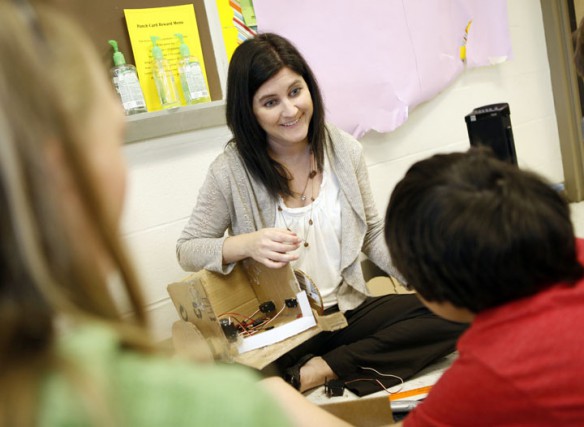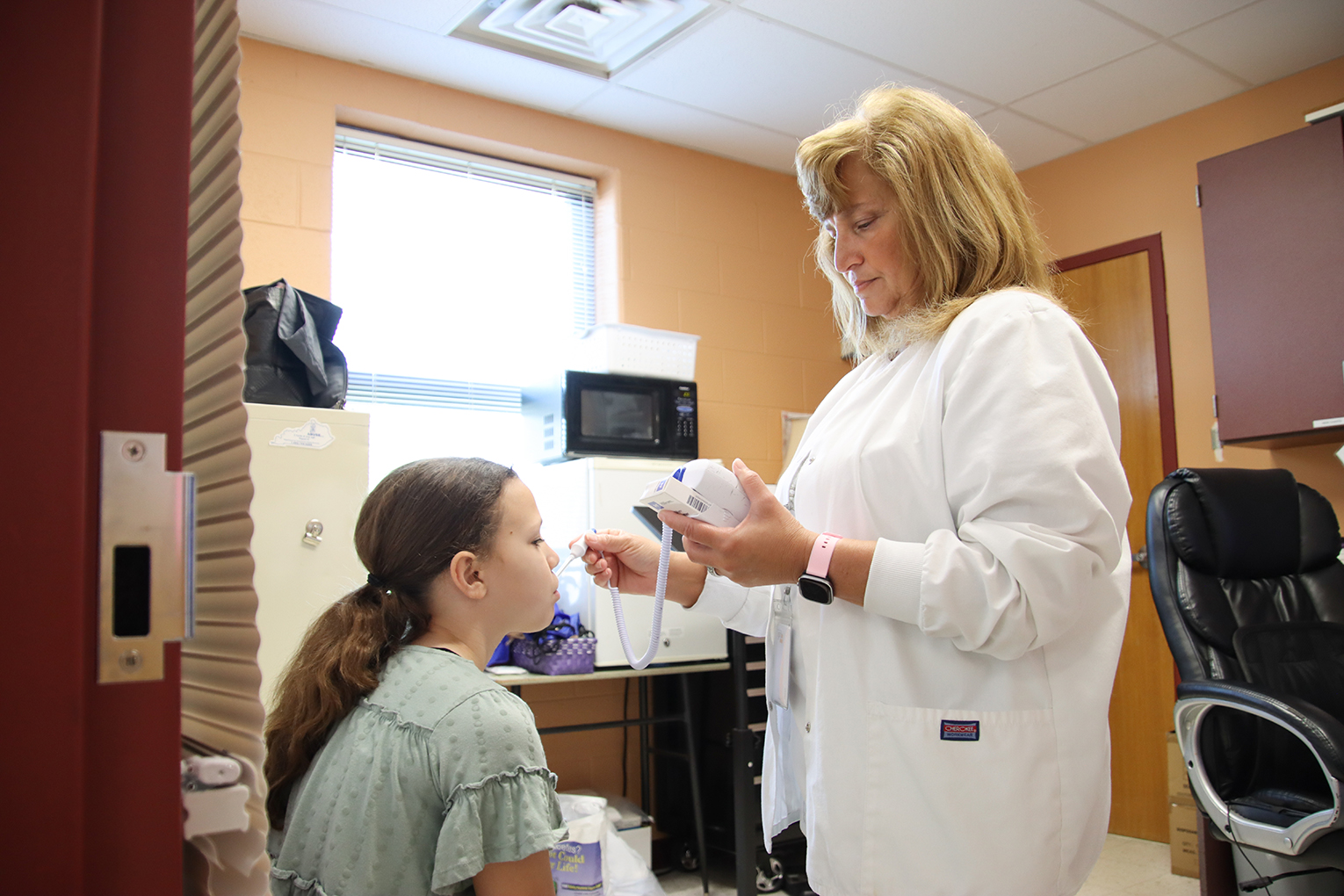
Rebecca Logan helps students come to their own conclusions during her 5th-grade STEM class at Elkhorn Elementary School (Franklin County). Photo by Amy Wallot, Nov. 9, 2011
By Susan Riddell
susan.riddell@education.ky.gov
A 5th-grade girl in Rebecca Logan’s class at Elkhorn Elementary School (Franklin County) had barely spoken during the first two months of the school year.
“She was so shy, and I don’t remember her being excited about anything in class,” Logan said.
But when the class was working on a Mars rover STEM (science, technology, engineering, mathematics) curriculum project, the girl’s model design was chosen by her team to be built and used for competition.
“That just validated something in her, and she totally took off with the unit we were studying,” Logan said. “I’ve just been blown away by this project and the curriculum. It’s really given my quieter students a voice and the confidence to take on more leadership roles. Every child is engaged. It’s just been amazing to watch.”
This past spring, Logan’s class piloted a STEM Mars rover project, which involved students working with radio-controlled car parts and batteries to create cardboard-constructed models. The lesson, made possible by Franklin County High School engineering instructor Mark Harrell and Project Lead the Way, was such a big hit with her students, Logan spent her summer researching ways to fill her curriculum with STEM activities throughout the day.
“I teach language arts in the morning, and the rest of the day is devoted to STEM,” Logan said. “STEM is just so important today if you are looking at the workforce. I think it’s a great idea to go ahead and introduce young students to it.
“This is the hardest thing I’ve taught,” added Logan, now in her 16th year of teaching, “but it’s been the most rewarding.”
Mindy Curless, STEM initiatives consultant for the Kentucky Department of Education, said these STEM lessons create learning opportunities that stay with students throughout their educational career.
“Successful STEM experiences integrate science, technology and mathematics through the meaningful application of engineering,” Curless said. “Ms. Logan’s STEM class focuses on projects that require students to use these disciplines to solve problems that the students care about.”
Such projects require students learn specific academic content, like behavior of light, characteristics of heat transfer, effects of forces on objects, or specific math skills, she said. They also benefit students in other ways.
“The practical application develops the lasting skills teachers hope to instill but can find difficult to achieve through a mathematics or science class that stands alone – things like number sense, interpreting data to make a decision, persevering to a solution even though it can be hard or messy at times,” Curless said.
This year, students in Logan’s class have made the Mars rovers, bird feeders out of two-liter bottles, paper microscopes, aluminum foil boats and gumdrop bridges. Given paper, tape and cardboard, they also had to construct a table prototype strong enough to hold the weight of two science books. Soon, her classes will be creating solar ovens and coin sorters.
Each unit comes with a writing assignment.
“These pieces can be explanatory, how to, or an opinion piece of writing,” Logan said. “Students tend to groan when you tell them they are going to write. However, these writing pieces are easy for the students to write due to the fact that they are writing about something familiar and something that they enjoy.”
Students Makenna Falor and Faith Lewis said they enjoyed making the bird feeders the most. For this project, they had to use tape, pencils, a hanger and a two-liter bottle.
“We had to make sure our birdfeeder was squirrel-proof,” Falor said. “We researched how to do that. It had to be (at least) six feet off the ground and six feet away from the tree (trunk). It had to be strong enough to hold a bird, too.”
“Arguably one of the most important aspects of this type of learning is that it develops the four C’s, known as 21st-century skills: creativity, critical thinking, collaboration and communication,” Curless said. “Developing these skills is a natural outcome of a STEM curriculum and perhaps the best reason to engage students in these experiences.”
Logan said the change in her curriculum has made her change some of her teaching practices, too.
“I have always been a control freak in the classroom, but to do this, you have to let go of a lot of the control,” she said. “If there’s a debate going on, you can’t cut it off. You have to let it continue because that’s where some of their decisions will come from.”
Logan also has to refrain from telling the students what to do. She routinely tells them, “It’s your decision” or “These are your options. You have to pick between them.” She said she does this to remind herself that while some of their choices won’t work, they need to see them fail so they understand why things don’t work. In turn, the students can eventually get to an approach that does work.
All students get to participate in all aspects of each unit.
For the Mars rover unit, there are teams of four. Each student goes through a brainstorming session and creates his or her own mockup of a rover. Instead of just voting for a friend’s model, students use a criteria system to rank each model based on certain traits. The model with the highest point total is chosen as the team’s model.
Each team member has to be prepared for any of the jobs involving the rover like mechanic, camera operator or co-pilot. When the rover competitions begin, students draw their jobs out a hat.
“Every kid is engaged all the time, and that’s what I love most about this,” Logan said.
MORE INFO …
Rebecca Logan, (502) 695-6730










[…] proficient in the 4 C’s: Creativity, Critical thinking, Collaboration and Communication. Mindy Curless, a Kentucky STEM initiatives consultant, asserts that “Developing these skills is a natural […]